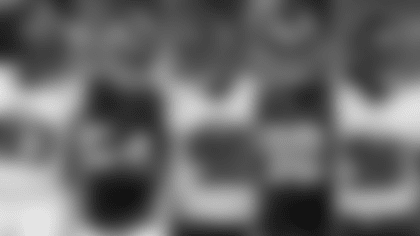"What do you see?"
Four words. One question.
This is the foundation of Jerry Gray's coaching philosophy.
The Falcons' assistant head coach/defense has seen it all. A Hall of Fame college career, an All-Pro professional stint and nearly three decades of accrued coaching has allowed Gray to experience everything the evolving game of football has to offer.
It's one thing to play the game for yourself, to see it unfold before your eyes. However, it's something else entirely to coach, to pass the game on to the next generation of players.
Which brings us to the question: "What do you see?"
Despite his years of experience and plays made at every level, Gray says often that it doesn't really matter what he sees, now does it? It matters what his players see. It's why he puts so much emphasis on perfecting the art of visualization in his coaching.
Coaching, at its core, is teaching.
The basis of Gray's best and most practiced teaching method manifested for him when he was just a young player; years before he was a first-round draft pick and well before a coaching career was ever in his sights.
Before he could teach his players about the art of visualization, Gray had to first be taught the art himself.
Jerry Gray was 18 years old, sitting in a team meeting during the early days of his freshman year at the University of Texas. It was the early '80s, and then-head coach Fred Akers had invited his old friend Lou Tice to speak to his team before the season began.
Tice was the founder of the Pacific Institute and specialized in the science of cognitive psychology, the study of how people think, learn and process information. He spent decades teaching others about the art of visualization, detailing in seminars and classes the power of visualizing success before it actually happens.
Tice's students included sports figures and company founders, but also generals, pilots and Navy men and women. Gray took special note of the latter group when he was younger, feeling as though he was learning something from someone who helped others "strategize to go to war." A fitting analogy seeing as the football field was his own battle ground.
When Gray was a freshman, he sat and listened to Tice. At the time, though, he didn't take too terribly much from that first lesson. But Tice kept coming back to Texas. Again and again he was there, through every offseason Gray was with the Longhorns. And each time, Tice would break down the game. He'd give the athletes tips and tools to help with their own practice of visualization while also strategizing ways to pick up player tendencies.
Gray found value in this method of powering the brain before the body. It became a factor in the standout playing career he would ultimately have, which included 297 career tackles, 16 interceptions and 20 passes broken up while playing on four bowl teams at Texas before accumulating 28 career interceptions en route to four Pro Bowl nods at the professional level.
"The brain is a lot more powerful than you give it credit for," Gray explained. "You can create a negative in your brain that's not even there, or you can create a positive in your brain that's not there, either. So, he taught us how to create positive stuff in our brain."
Today, this is a teaching Gray passes on, and every week follows the same routine that reinforces this method.
It starts in the film room.
Gray flips off the lights in the Falcons secondary's meeting room, cuts on the film and hits play. He doesn't watch the screen, though. He's already done so. He watches his players, instead.
He sees their eyes follow the players on the screen. He notices their hands jotting down notes. Every now and again Gray will pipe up with a note or two. If he says something three times, it better get written down. Chances are high Gray's note about a tendency shows up on game day.
Throughout the session, Gray often asks, "What do you see?"
Once the session is over comes the next step: visualization.
"Now you take that film, and you take your notes, and then you put yourself in the film," Gray said.
"Superimpose yourself to see yourself making the play."
The brain is a powerful tool, but it's also a finicky one. Players like Justin Simmons and Jessie Bates III agree, so much so that they firmly believe the brain doesn't know the difference between a mental and physical rep. Gray believes in this, too.
So, the idea is that before the body plays on Sunday, the mind has already repped the game plan multiple times, creating neural pathways in the brain that are needed to execute those plays in real life. According to Gray, it's the difference in the goods versus the greats.
"Some players, they wait until Sunday to try to make great plays," he said. "But I tell them, 'If you go Wednesday, Thursday, Friday and you make those plays in the chair, you will make the plays on Sunday, too.'"
For players, these sessions are invaluable.
"I think being able to sit back and dissect film with an All-Pro, Pro Bowler, who's gotten interceptions, who knows how to set plays up, knows what it feels like, what it looks like, I think that — to me — has been such a joy to be around," Simmons said.
The defensive backs in Atlanta have given Gray a nickname. They call him "OG." The original. And if you ever hear anyone in the Falcons secondary address Gray, they exclusively address him as "OG." It's a sign of respect for what he's seen and what he teaches them.
"He's very old school," Mike Hughes said. "But the visualization, it really relates to me because when I'm watching film, that's all I imagine myself doing: making plays.
"He's seen everything, from his playing days to his coaching days, he knows how to verbalize things to make it super simple."
That's a major piece of the players' respect for Gray and his methods. He has a player's eye in the body of a coach, Bates explained. It's why it matters to Gray — and his pupils — that he asks them what they see.
"He wants to hear the feedback from us to figure out the best solution for us as a DB group," Bates said. "… Those meetings are some of the best meetings that I've been in where it's not, 'We're just doing it this way and that's the only way we can do it.' He's super open to hearing how we see it so we can all get on the same page.
"It's very valuable, that wisdom that's coming from OG."
But despite the emphasis on visualization in film study, it doesn't stop in the video room. The first question Gray asks players as they come off the field after every defensive series on Sundays is the exact same.
"What did you see?"
"If they can explain to me what they saw, then I can help them," Gray said. "But if you can't explain what you saw, then it's going to be hard for me to help you."
The tools the players need to make the plays on the field are already safely stored in their own heads. Sometimes they just need a little help getting the brain unlocked. That's what Gray is there for. It's something he specializes in.
"He's one of the best I have been around," Simmons said of Gray. "First of all, I have tremendous respect for all coaches, especially in the NFL ... but I have the utmost and ultimate respect for those who have played before. They understand. They know what it looks like. They know what it's supposed to be like. Jerry is the epitome of that."
Through the art of visualization, Gray is molding the minds of the Falcons secondary, teaching them that success begins in the mind long before it happens on the field. He's doing so four words and one question at a time.
















